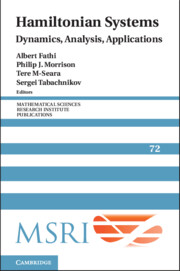Book contents
- Frontmatter
- Contents
- Denjoy subsystems and horseshoes
- Impact Hamiltonian systems and polygonal billiards
- Some remarks on the classical KAM theorem, following Pöschel
- Some recent developments in Arnold diffusion
- Viscosity solutions of the Hamilton–Jacobi equation on a noncompact manifold
- Holonomy and vortex structures in quantum hydrodynamics
- Surfaces of locally minimal flux
- A symplectic approach to Arnold diffusion problems
- Hamiltonian ODE, homogenization, and symplectic topology
- References
Denjoy subsystems and horseshoes
Published online by Cambridge University Press: 10 May 2024
- Frontmatter
- Contents
- Denjoy subsystems and horseshoes
- Impact Hamiltonian systems and polygonal billiards
- Some remarks on the classical KAM theorem, following Pöschel
- Some recent developments in Arnold diffusion
- Viscosity solutions of the Hamilton–Jacobi equation on a noncompact manifold
- Holonomy and vortex structures in quantum hydrodynamics
- Surfaces of locally minimal flux
- A symplectic approach to Arnold diffusion problems
- Hamiltonian ODE, homogenization, and symplectic topology
- References
Summary
We introduce a notion of weak Denjoy subsystem (WDS) that generalizes the Aubry–Mather–Cantor sets to diffeomorphisms of manifolds. We explain how a rotation number can be associated to such a WDS. Then we build in any horseshoe a continuous one parameter family of such WDS that is indexed by its rotation number. Looking at the inverse problem in the setting of Aubry– Mather theory, we also prove that for a generic conservative twist map of the annulus, the majority of the Aubry–Mather sets are contained in some horseshoe that is associated to an Aubry–Mather set with a rational rotation number.
Keywords
- Type
- Chapter
- Information
- Hamiltonian SystemsDynamics, Analysis, Applications, pp. 1 - 28Publisher: Cambridge University PressPrint publication year: 2024

